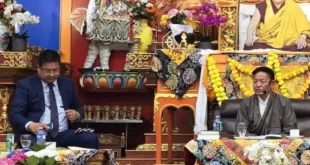tibet.net
May 14, 2014
DHARAMSHALA: The Himachal Pradesh University (HPU) in coordination with the Tibet Policy Institute of the Central Tibetan Administration brought together scholars to revisit the Shimla convention of 1914 to explore Tibet’s role for better relations between India and China.
Speaking at the one-day conference in Shimla on 12 May, HPU Vice-Chancellor Prof A D N Bajpai said the Sino-Indian relations vis-à-vis Tibet is a very complex issue and it cannot be resolved within a span of few days of conference like this.
“The issue of Tibet plays a prominent role in the Sino-India relations, “he said, adding that “Tibet as a sovereign country will be significant for India because of its strategic location.” “If Tibet remained as a sovereign nation, the budget that India spends today on military build-up on its border will be minimal.”
Mr Tashi Phuntsok, secretary for the Central Tibetan Administration’s Department of Information and International Relations, said: “We have come here not to celebrate the century of the agreement, but to recall the historic time as history is not static. We hope for a better future for our people.”

He said Tibetans defended their country from the invading forces of the British India when the latter was very powerful in the early 20th century. After it failed make inroads into Tibet through negotiations with China, it sent a military expedition led by Colonel Francis Younghusband to invade Tibet.
Tibetan Policy Institute director Mr Thubten Samphel said that Tibet was the key for improving relations between India and China and burial of the Shimla agreement 1914 would not improve relations between the two nations. “Tibet is today what India was 100 years back and situations do change for good,” he said.
The Turkmenistan-Afghanistan-Pakistan-Indian (TAPI) gas pipeline and alternate trade route through India are two major economic compulsions of China which could be negotiated to end border disputes between China, Tibet and India. “The trade route through the Indian Ocean to the Bay of Bengal and pipeline from Central Asia via Exchine to Manali, which is the shortest route, could help resolve the century-old issue as China has vital economic interests in the region,” said Prof RS Yadav from Kurukshetra University, The Tribune reported.
He said three nations had divergent interests as Britain wanted to secure its northern borders, China wanted suzerainty rights (one country’s rule over another) over Tibet and Tibet wanted independence (sovereignty) but international diplomacy, in which Tibet did not have any major say, prevailed and later, India and Britain also accepted Tibet as a part of China.
Mr Dhondup Gyalpo, a researcher at the Tibet Policy Institute, spoke on Tibetan perspectives on Shimla convention.
The Shimla convention between India, Tibet and China was held from 1913 to1914 to define and demarcate the boundaries of inner and outer Tibet and between India and China. Though China initialed the agreement that came out of the convention and refused to sign the final document. In the end, Tibet and British India signed the final document in between the two as the McMahon Line along India’s north – east. Even after 100 years, that document is a cause of disagreement between India and China. The legitimacy of that agreement is still in question, because of the fact that China was not signatory to the agreement and the agreement was signed by Tibet and British India.



